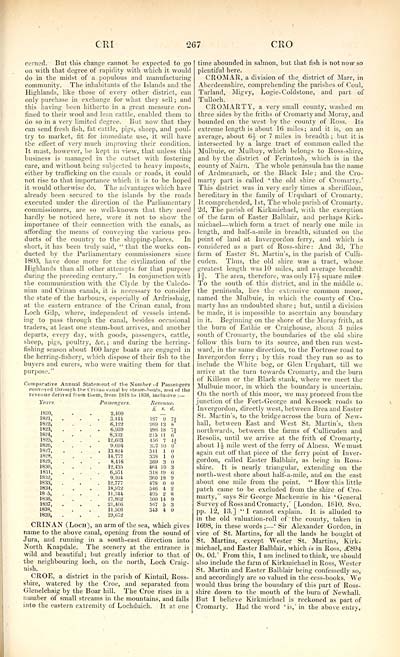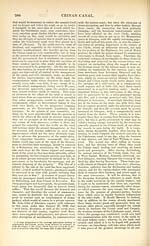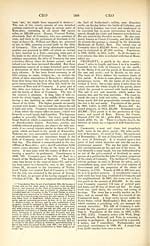Topographical, statistical, and historical gazetteer of Scotland > Volume 1
(349) Page 267 - CRI
Download files
Complete book:
Individual page:
Thumbnail gallery: Grid view | List view

CRI
267
CRO
corned. But this change cannot be expected to go
on with that degree of rapidity with which it would
do in the midst of a populous and manufacturing
community. The inhabitants of the Islands and the
Highlands, like those of every other district, can
only purchase in exchange for what they sell ; and
this having been hitherto in a great measure con-
fined to their wool and lean cattle, enabled them to
do so in a very limited degree. But now that they
can send fresh fish, fat cattle, pigs, sheep, and poul-
try to market, fit for immediate use, it will have
the effect of very much improving their condition.
It must, however, be kept in view, that unless this
business is managed in the outset with fostering
care, and without being subjected to heavy imposts,
either by trafficking on the canals or roads, it could
not rise to that importance which it is to be hoped
it would otherwise do. The advantages which have
already been secured to the islands by the roads
executed under the direction of the Parliamentary
commissioners, are so well-known that they need
hardly be noticed here, were it not to show the
importance of their connection with the canals, as
affording the means of conveying the various pro-
ducts of the country to the shipping-places. In
short, it has been truly said, " that the works con-
ducted by the Parliamentary commissioners since
1803, have done more for the civilization of the
Highlands than all other attempts for that purpose
during the preceding century." In conjunction with
the communication with the Clyde by the Caledo-
nian and Crinan canals, it is necessary to consider
the state of the harbours, especially of Ardrisshaig,
at the eastern entrance of the Crinan canal, from
Loch Gilp, where, independent of vessels intend-
ing to pass through the canal, besides occasional
traders, at least one steam-boat arrives, and another
departs, every day, with goods, passengers, cattle,
sheep, pigs, poultry, &c. ; and during the herring-
fishing season about 100 large boats are engaged in
the herring-fishery, which dispose of their fish to the
buyers and curers, who were waiting them for that
purpose."
Comparative Annual Statement of tbe
conveyed through the Crinau canal by
revenue derived from tliem, from 1818
Number of Passengers
steam-boats, and of the
i to 1838, inclusive :—
Years.
Piusejigers.
Revenue.
£ s. d.
1820,
2,400
1821,
3.441
187 9 7J
1822,
6,122
269 13 8
1823,
6,939
286 18 71
1824,
8,332
215 11 6
1825,
. 12,603
456 7 41
1826,
9,094
307 10
1827,
. 13,824
511 1
1828,
14,777
33S 1
1829,
8,416
369 3
1830,
12,435
464 10 3
1831,
6,571
313 19 6
1832,
9,594
360 18 9
1833, .
. 12,777
478
1834,
18,972
546 4 2
18 5,
. 11,341
405 2 8
1836,
17,862
500 14 9
1837, .
. 21,406
567 5 3
1838,
1 1 ,506
343 4
1839,
. 19,672
CRINAN (Loch), an arm of the sea, which gives
name to the above canal, opening from the sound of
Jura, and running in a south-east direction into
North Knapdale. The scenery at the entrance is
wild and beautiful; but greatly inferior to that of
the neighbouring loch, on the north, Loch Craig-
nish.
CROE, a district in the parish of Kintail, Ross-
shire, watered by the Croe, and separated from
Glenelchaig by the Boar hill. The Croe rises in a
number of small streams in the mountains, and falls
into the eastern extremity of Lochduich. It at one
time abounded in salmon, but that fish is not now so
plentiful here.
CROMAR, a division of the district of Marr, in
Aberdeenshire, comprehending the parishes of Coul,
Tarland, Migvy, Logie-Coldstone, and part of
Tulloch.
CROMARTY, a very small county, washed on
three sides by the friths of Cromarty and Moray, and
bounded on the west by the county of Ross. Its
extreme length is about 16 miles; and it is, on an
average, about 6^ or 7 miles in breadth ; but it is
intersected by a large tract of common called the
Mulbuie, or Mulbuy, which belongs to Ross-shire,
and by the district of Ferintosh, which is in the
county of Nairn. The whole peninsula has the name
of Ardmeanach, or the Black Isle ; and the Cro-
marty part is called ' the old shire of Cromarty. '
This district was in very early times a sheriffdom,
hereditary in the family of Urquhart of Cromarty.
It comprehended, 1st, The whole parish of Cromarty.
2d, The parish of Kirkmichael, with the exception
of the farm of Easter Balblair, and perhaps Kirk-
michael — which form a tract of nearly one mile in
length, and half-a-mile in breadth, situated on the
point of land at Invergordon ferry, and which is
considered as a part of Ross-shire : And 3d, The
farm of Easter St. Martin's, in the parish of Culli-
cuden. Thus, the old shire was a tract, whose
greatest length was 10 miles, and average breadth
If. The area, therefore, was only 17i square mile*
To the south of this district, and in the middle o.
the peninsula, lies the extensive common moor,
named the Mulbuie, in which the county of Cro-
marty has an undoubted share ; but, until a division
be made, it is impossible to ascertain any boundary
in it. Beginning on the shore of the Moray frith, at
the burn of Eathie or Craighouse, about 3 niiles
south of Cromarty, the boundaries of the old shire
follow this burn to its source, and then run west-
ward, in the same direction, to the Fortrose road to
Invergordon ferry ; by this road they run so as to
include the White bog, or Glen Urquhart, till we
arrive at the turn towards Cromarty, and the burn
of Killean or the Black stank, where we meet the
Mulbuie moor, in which the boundary is uncertain.
On the north of this moor, we may proceed from the
junction of the Fort-George and Kessock roads to
Invergordon, directly west, between Brea and Easter
St. Martin's, to the bridge across the burn of New-
hall, between East and West St. Martin's, then
northwards, between the farms of Cullicuden and
Resolis, until we arrive at the frith of Cromarty,
about 1J mile west of the ferry of Alness. We must
again cut off that piece of the ferry point of Inver-
gordon, called Easter Balblair, as being in Ross-
shire. It is nearly triangular, extending on the
north-west shore about half-a-mile, and on the east
about one mile from the point. " How this little
patch came to be excluded from the shire of Cro-
marty," says Sir George Mackenzie in his 'General
Survey of Ross and Cromarty,' [London. 1810. 8vo.
pp. 12, 13.] "I cannot explain. It is alluded to
in the old valuation-roll of ~ the county, taken in
1698, in these words ; — ' Sir Alexander Gordon, in
vice of St. Martins, for all the lands he bought of
St. Martins, except Wester St. Martins, Kirk-
michael, and Easter Balblair, which is in Ross, £894
0s. 0d.' From this, I am inclined to think, we should
also include the farm of Kirkmichael in Ross, Wester
St. Martin and Easter Balblair being confessedly so,
and accordingly are so valued in the cess-books. We
would thus bring the boundary of this part of Ross-
shire down to the mouth of the burn of Newhall.
But I believe Kirkmichael is reckoned as part of
Cromarty. Had the word 'is,' in the above entry,
267
CRO
corned. But this change cannot be expected to go
on with that degree of rapidity with which it would
do in the midst of a populous and manufacturing
community. The inhabitants of the Islands and the
Highlands, like those of every other district, can
only purchase in exchange for what they sell ; and
this having been hitherto in a great measure con-
fined to their wool and lean cattle, enabled them to
do so in a very limited degree. But now that they
can send fresh fish, fat cattle, pigs, sheep, and poul-
try to market, fit for immediate use, it will have
the effect of very much improving their condition.
It must, however, be kept in view, that unless this
business is managed in the outset with fostering
care, and without being subjected to heavy imposts,
either by trafficking on the canals or roads, it could
not rise to that importance which it is to be hoped
it would otherwise do. The advantages which have
already been secured to the islands by the roads
executed under the direction of the Parliamentary
commissioners, are so well-known that they need
hardly be noticed here, were it not to show the
importance of their connection with the canals, as
affording the means of conveying the various pro-
ducts of the country to the shipping-places. In
short, it has been truly said, " that the works con-
ducted by the Parliamentary commissioners since
1803, have done more for the civilization of the
Highlands than all other attempts for that purpose
during the preceding century." In conjunction with
the communication with the Clyde by the Caledo-
nian and Crinan canals, it is necessary to consider
the state of the harbours, especially of Ardrisshaig,
at the eastern entrance of the Crinan canal, from
Loch Gilp, where, independent of vessels intend-
ing to pass through the canal, besides occasional
traders, at least one steam-boat arrives, and another
departs, every day, with goods, passengers, cattle,
sheep, pigs, poultry, &c. ; and during the herring-
fishing season about 100 large boats are engaged in
the herring-fishery, which dispose of their fish to the
buyers and curers, who were waiting them for that
purpose."
Comparative Annual Statement of tbe
conveyed through the Crinau canal by
revenue derived from tliem, from 1818
Number of Passengers
steam-boats, and of the
i to 1838, inclusive :—
Years.
Piusejigers.
Revenue.
£ s. d.
1820,
2,400
1821,
3.441
187 9 7J
1822,
6,122
269 13 8
1823,
6,939
286 18 71
1824,
8,332
215 11 6
1825,
. 12,603
456 7 41
1826,
9,094
307 10
1827,
. 13,824
511 1
1828,
14,777
33S 1
1829,
8,416
369 3
1830,
12,435
464 10 3
1831,
6,571
313 19 6
1832,
9,594
360 18 9
1833, .
. 12,777
478
1834,
18,972
546 4 2
18 5,
. 11,341
405 2 8
1836,
17,862
500 14 9
1837, .
. 21,406
567 5 3
1838,
1 1 ,506
343 4
1839,
. 19,672
CRINAN (Loch), an arm of the sea, which gives
name to the above canal, opening from the sound of
Jura, and running in a south-east direction into
North Knapdale. The scenery at the entrance is
wild and beautiful; but greatly inferior to that of
the neighbouring loch, on the north, Loch Craig-
nish.
CROE, a district in the parish of Kintail, Ross-
shire, watered by the Croe, and separated from
Glenelchaig by the Boar hill. The Croe rises in a
number of small streams in the mountains, and falls
into the eastern extremity of Lochduich. It at one
time abounded in salmon, but that fish is not now so
plentiful here.
CROMAR, a division of the district of Marr, in
Aberdeenshire, comprehending the parishes of Coul,
Tarland, Migvy, Logie-Coldstone, and part of
Tulloch.
CROMARTY, a very small county, washed on
three sides by the friths of Cromarty and Moray, and
bounded on the west by the county of Ross. Its
extreme length is about 16 miles; and it is, on an
average, about 6^ or 7 miles in breadth ; but it is
intersected by a large tract of common called the
Mulbuie, or Mulbuy, which belongs to Ross-shire,
and by the district of Ferintosh, which is in the
county of Nairn. The whole peninsula has the name
of Ardmeanach, or the Black Isle ; and the Cro-
marty part is called ' the old shire of Cromarty. '
This district was in very early times a sheriffdom,
hereditary in the family of Urquhart of Cromarty.
It comprehended, 1st, The whole parish of Cromarty.
2d, The parish of Kirkmichael, with the exception
of the farm of Easter Balblair, and perhaps Kirk-
michael — which form a tract of nearly one mile in
length, and half-a-mile in breadth, situated on the
point of land at Invergordon ferry, and which is
considered as a part of Ross-shire : And 3d, The
farm of Easter St. Martin's, in the parish of Culli-
cuden. Thus, the old shire was a tract, whose
greatest length was 10 miles, and average breadth
If. The area, therefore, was only 17i square mile*
To the south of this district, and in the middle o.
the peninsula, lies the extensive common moor,
named the Mulbuie, in which the county of Cro-
marty has an undoubted share ; but, until a division
be made, it is impossible to ascertain any boundary
in it. Beginning on the shore of the Moray frith, at
the burn of Eathie or Craighouse, about 3 niiles
south of Cromarty, the boundaries of the old shire
follow this burn to its source, and then run west-
ward, in the same direction, to the Fortrose road to
Invergordon ferry ; by this road they run so as to
include the White bog, or Glen Urquhart, till we
arrive at the turn towards Cromarty, and the burn
of Killean or the Black stank, where we meet the
Mulbuie moor, in which the boundary is uncertain.
On the north of this moor, we may proceed from the
junction of the Fort-George and Kessock roads to
Invergordon, directly west, between Brea and Easter
St. Martin's, to the bridge across the burn of New-
hall, between East and West St. Martin's, then
northwards, between the farms of Cullicuden and
Resolis, until we arrive at the frith of Cromarty,
about 1J mile west of the ferry of Alness. We must
again cut off that piece of the ferry point of Inver-
gordon, called Easter Balblair, as being in Ross-
shire. It is nearly triangular, extending on the
north-west shore about half-a-mile, and on the east
about one mile from the point. " How this little
patch came to be excluded from the shire of Cro-
marty," says Sir George Mackenzie in his 'General
Survey of Ross and Cromarty,' [London. 1810. 8vo.
pp. 12, 13.] "I cannot explain. It is alluded to
in the old valuation-roll of ~ the county, taken in
1698, in these words ; — ' Sir Alexander Gordon, in
vice of St. Martins, for all the lands he bought of
St. Martins, except Wester St. Martins, Kirk-
michael, and Easter Balblair, which is in Ross, £894
0s. 0d.' From this, I am inclined to think, we should
also include the farm of Kirkmichael in Ross, Wester
St. Martin and Easter Balblair being confessedly so,
and accordingly are so valued in the cess-books. We
would thus bring the boundary of this part of Ross-
shire down to the mouth of the burn of Newhall.
But I believe Kirkmichael is reckoned as part of
Cromarty. Had the word 'is,' in the above entry,
Set display mode to: Large image | Transcription
Images and transcriptions on this page, including medium image downloads, may be used under the Creative Commons Attribution 4.0 International Licence unless otherwise stated. ![]()
| Gazetteers of Scotland, 1803-1901 > Topographical, statistical, and historical gazetteer of Scotland > Volume 1 > (349) Page 267 - CRI |
|---|
| Permanent URL | https://digital.nls.uk/97441734 |
|---|
| Description | Volume first. A-H. |
|---|---|
| Attribution and copyright: |
|

